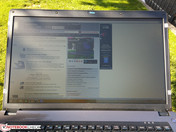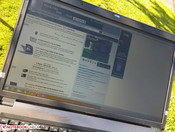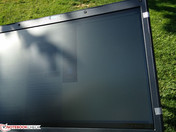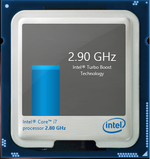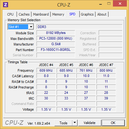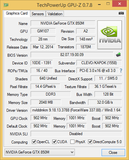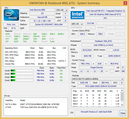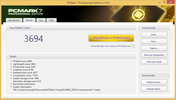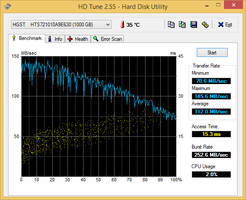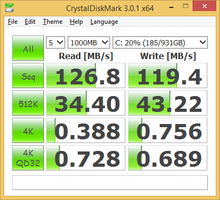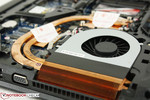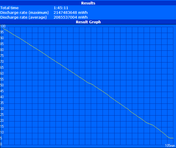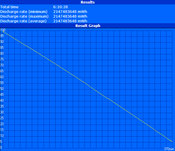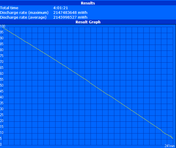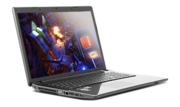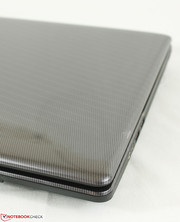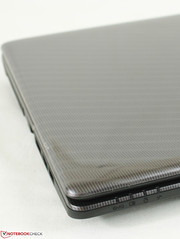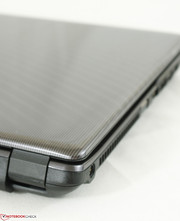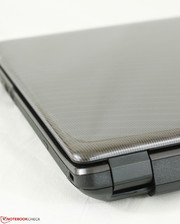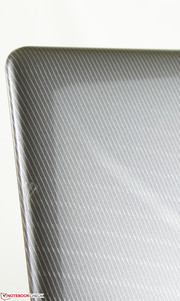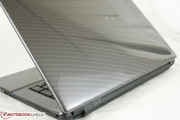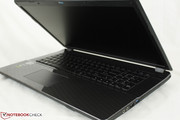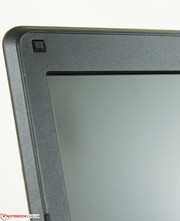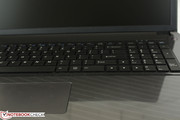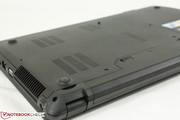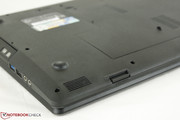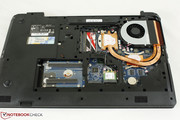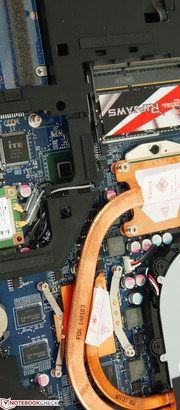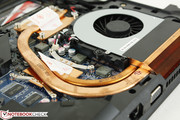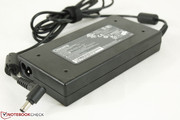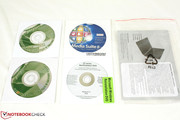iBuyPower Battalion 101 W670SJQ Notebook Review
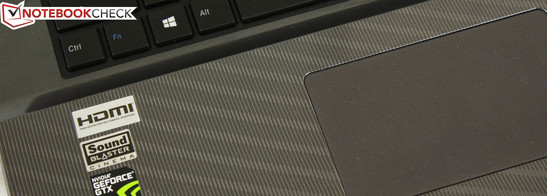
Aside from their more well-known Valkyrie series of notebooks, reseller iBuyPower offers a more down-to-earth lineup of Battalion models geared at the more budget-conscious gamers. These models are based on the popular Clevo barebones that are common amongst other resellers including Eurocom, XMG, and Digital Storm in the United States.
For this review, we take a quick look at the 17.3-inch Battalion 101 W670SJQ based on none other than the Clevo W670SJQ barebones. The model may not have the stylish looks or extremely high-end specs of its Valkyrie siblings, but it costs hundreds less while being perfectly capable of playing the same intensive PC titles at Full HD resolution.
Since we have already taken a close look at the Clevo W670SJQ chassis, we refer to our previous review on the Nexoc M731 for more details on the case, connectivity, inputs, and the overall construction quality as these features are similar to our Battalion model on hand. Instead, let's jump right to the hardware and benchmarks that power the iBuyPower. How does the Battalion fare against the bigger names like tje Asus ROG, Alienware, and MSI G Series?
Display
A display resolution of 1080p is the standard for a 17.3-inch gaming notebook and, at this size, we certainly would not have wanted anything less. The TN screen is subjectively crisp and bright with deep colors. Unfortunately, the screen suffers from the same grainy qualities that it shares with the Asus G75VW, another 17.3-inch gamer with the same Chi Mei N173HGE TN panel. This does not affect day-to-day use or visibility, but it can be tough to ignore especially for users who are accustomed to the crisper images provided by glossy screens.
The measured average brightness of about 320 nits is more than sufficient for indoor use. Maximum brightness does not artificially drop if running on batteries and the matte display assures that indoor glare will not interfere when gaming. Contrast, however, could have been higher at only around 400:1. This is compared to the Nexoc M731 and MSI GT70, both of which have measured contrast ratios twice that of the Battalion. Nonetheless, we found the black levels to be more than adequate for gaming and move playback.
| |||||||||||||||||||||||||
Brightness Distribution: 86 %
Center on Battery: 327.3 cd/m²
Contrast: 402:1 (Black: 0.814 cd/m²)
ΔE Color 4.67 | 0.5-29.43 Ø5
ΔE Greyscale 5.22 | 0.57-98 Ø5.3
55.06% AdobeRGB 1998 (Argyll 1.6.3 3D)
62.7% AdobeRGB 1998 (Argyll 2.2.0 3D)
85.4% sRGB (Argyll 2.2.0 3D)
62.5% Display P3 (Argyll 2.2.0 3D)
Gamma: 2.19
Color reproduction is approximately 75 percent and 55 percent of the sRGB and AdobeRGB standards, respectively. This is significantly better than budget panels where 60 percent of sRGB is the norm and similar to other gaming notebooks like the Alienware 17 and GT70. Despite this, these notebooks are no workstations and are not intended for professional graphics work as demonstrated by the low AdobeRGB coverage. A high color gamut is not crucial to the target audience in this respect.
Further color analyses with an X-Rite i1Basic Pro 2 spectrophotometer shows highly inaccurate colors and grayscale out-of-the-box. Grays and blacks are too blue and colors become less accurate at lower saturation levels. Luckily, a quick calibration corrects many of these shortcomings by lowering the cool color temperature significantly and improving the RGB balance to admittedly impressive levels. As a result, colors see a large boost in accuracy across all saturation levels.
As expected, outdoor usability is limited by the weight of the unit as gaming notebooks are generally not fit for extended use away from an outlet. Nonetheless, the matte display diffuses glare and reflections for easier viewing while the bright backlight is passable at maximum brightness on brighter days. Direct sunlight should still be avoided as usual or else texts and images will appear washed out.
Viewing angle stability is typical of a TN panel. Colors are more stable if viewing from the sides or above the center, and will degrade quickly if viewing from below the normal. Sharing the display with other viewers should not be a problem due to the large 17.3-inch screen.
Performance
The heart of our Battalion W670SJQ is the Core i7-4900MQ, a high-end 2.8 GHz Haswell CPU capable of Turbo Boost up to 3.6 GHz for four active cores. If on Power Saver mode, all cores will underclock to 800 MHz to reduce power consumption. Note that iBuyPower offers additional CPU choices including the slightly slower 2.4 GHz i7-4810MQ and the even faster 2.9 GHz i7-4910MQ. These CPUs are some of the fastest mobile Haswell cores available with marginal performance differences between them in everyday tasks. More information and benchmarks on the equipped i7-4900MQ can be found in our dedicated CPU page here.
Though the manufacturer allows configurable CPUs, all GPU options are fixed. The integrated HD 4600 is standard amongst the high-end Core i7 lineup and the GTX 850M is soldered onto the board. The notebook includes no MXM 3.0 ports for installation of a more powerful GTX 870M/880M or AMD equivalent, so users are stuck with the upper mid-range GTX 850M for Optimus. If idling and in Power Saver mode, the GPU will operate at a low 135/405 MHz core/memory to reduce power consumption. At maximum power, the core operates at a high 1084.5/1001 MHz. More information and benchmarks on the GTX 850M can be found in out dedicated GPU page here.
RAM is provided by a single 8 GB G.Skill RipJaws PC3-12800 SODIMM module out of the two available slots. Users can upgrade up to 16 GB, which should be more than sufficient for gaming and multitasking. Access to the HDD, mSATA, half mini PCI-e, CPU, GPU, SODIMM slots and system fan is quick and easy from the bottom of the unit.
Processor
Synthetic CPU benchmarks place the Battalion W670SJQ in the same ballpark as other notebooks sporting the same CPU, including the expensive HP ZBook 17 and Dell Precision M4800 mobile workstations. Final scores across the board are very similar to other high-end Haswell cores including the i7-4910MQ and i7-4700MQ. Note that upgrading to an i7-4910MQ is an additional $350, so the return in investment is marginal when dealing with top-of-the-line CPUs. When compared to the more common middle ground i5-3210M of the previous generation, however, the multi-core wPrime benchmark will complete roughly twice as fast with the i7-4900MQ. In general, users can expect performance levels to be slightly above the Ivy Bridge i7-3840QM.
System Performance
The PCMark 7 score of 3694 points is on par with lower-end systems equipped with SSDs as the benchmark is heavily biased towards SSD-based systems. For example, the Lenovo IdeaPad Yoga 11S and Dell Latitude E5540 score 3694 and 3693 points, respectively, in the same benchmark. Fortunately, PCMark 8 Home places the Battalion in the same ballpark as competitors sporting very similar specifications like the MSI GE70 and Asus N550JK as the benchmark does not take into account storage performance. Nonetheless, we were unable to complete PCMark 8 Work and PCMark 8 Storage due to unexpected errors during the benchmark runs.
Subjectively, system performance is quick for a system with no dedicated SSD. Navigating the graphics-heavy Windows 8 UI feels snappy with little lag or delays. Launching applications still feel a step slower compared to SSD-driven Ultrabooks, however, so there is still room for improvement.
| PCMark 7 Score | 3694 points | |
| PCMark 8 Home Score Accelerated v2 | 3267 points | |
| PCMark 8 Creative Score Accelerated v2 | 3686 points | |
Help | ||
Stress Test
We stress the notebook to observe any potential throttling or stability issues. With only Prime95 active to stress the CPU, we recorded a maximum CPU temperature of about 80 degrees C with HWiNFO. The i7-4900MQ was able to maintain a frequency of 3.2 GHz, which is 400 MHz less than its rated Turbo Boost for four active cores.
Next, FurMark was used to stress the Nvidia GPU. GPU-Z recorded a temperature of about 70 degrees C and a core/memory clock of 1084.5/1001 MHz. The GPU never dipped below these clock frequencies under the heavy load.
When under full stress from both Prime95 and FurMark simultaneously, both the CPU and GPU of the Battalion were able to maintain 3.1 - 3.2 GHz and 1084.5/1001 MHz frequencies, respectively. CPU temperature rises to 92 degrees C while the GPU can go over 86 degrees C under this extreme state, but we experienced no stability or throttling issues. A quick 3DMark 11 run immediately after the stress test produced a final score of 4597 points, which is a statistically insignificant change from its final score of 4604 points before the stress test.
Running on battery power will not artificially reduce CPU and GPU speeds, so users can enjoy the full power of the notebook even without an outlet nearby. A 3DMark 11 run on battery resulted in a final score of 4407 points.
Storage Devices
Our test notebook uses a single 1 TB Hitachi Travelstar HDD, though iBuyPower offers a plethora of SSD and HDD options of different capacities. Note that an mSATA slot is available as well for those who want the benefits of an SSD while keeping the capacity advantage of a mechanical drive. RAID between the SATA III and mSATA drives does not appear to be supported.
With an average transfer rate of 112 Mb/s according to HD Tune, our equipped 7200 RPM Hitachi drive is very fast as most other 7200 RPM drives typically fall in the 90 MB/s range. Even so, this pales compared to a standard SSD. Unless if the Battalion will be used mostly for gaming, we suggest installing an SSD as a primary boot device or secondary storage for applications.
See here for our growing comparison list of HDD and SSD benchmarks.
Gaming Performance
General performance from the dedicated Maxwell GTX 850M can be good or bad depending on the expectations of the user. The GPU is an odd model in that it is an upper mid-range card, yet it utilizes slow 2 GB DDR3 VRAM tied to a narrow 128-bit memory bus when most cards in its class have much faster GDDR5 VRAM. This is perhaps the biggest difference that separates it from the much faster GTX 860M, 870M and 880M. The GTX 850M makes up this deficit with faster base clock speeds: 876 MHz vs. 657 MHz of the older GTX 760M that it supplants. Despite this, the limited bandwidth takes its toll when running today's titles at very high or Ultra settings.
The games tested below show that the GPU begins to buckle at Ultra settings. Users expecting 1080p60 or even 1080p30 will have to tune down particles and bandwidth-heavy effects like supersampling. Frame rates drop dramatically when moving from High to Ultra in most titles, so we encourage the use of v-sync in first-person shooters for more consistent input latency and to prevent screen tears. Otherwise, a reduction in resolution would be the easiest (and ugliest) solution for smoother gameplay in more demanding games.
| 3DMark 06 Standard Score | 21644 points | |
| 3DMark 11 Performance | 4604 points | |
| 3DMark Ice Storm Standard Score | 90517 points | |
| 3DMark Cloud Gate Standard Score | 13699 points | |
| 3DMark Fire Strike Score | 2853 points | |
| 3DMark Fire Strike Extreme Score | 1456 points | |
Help | ||
| low | med. | high | ultra | |
| Sleeping Dogs (2012) | 62 | 16 | ||
| Guild Wars 2 (2012) | 55 | 25 | ||
| Crysis 3 (2013) | 38 | 14 | ||
| Tomb Raider (2013) | 67 | 31 | ||
| StarCraft II: Heart of the Swarm (2013) | 96 | 35 | ||
| BioShock Infinite (2013) | 82 | 30 | ||
| Metro: Last Light (2013) | 42 | 20 | ||
| Battlefield 4 (2013) | 58 | 19 |
Emissions
System Noise
Like many other Clevo barebones, the system uses a single fan to cool both the CPU and GPU as opposed to a dual fan solution a la the Aorus X7, Asus ROG or Alienware 17. Of course, these latter 17.3-inch notebooks also sport much faster GPUs, so a single fan setup for the Battalion is sufficient for the task. Idling, word processing, or web surfing will result in an almost silent fan.
Nonetheless, the system fan will kick into high gear very abruptly if under medium or higher loads. This is especially true if the notebook is under the High Performance or Balanced profile where the fan will jump from 30 dB(A) to 40 dB(A) for a few seconds, only to drop back to 30 dB(A). It's not frequent enough to be considered a pulsing phenomenon, but it is definitely noticeable during everyday use. Sustained higher loads will bump fan noise even louder to a recorded 53.1 dB(A). We recommend working with the Power Saver profile if only non-demanding tasks are necessary.
Noise Level
| Idle |
| 30.2 / 30.6 / 35.1 dB(A) |
| DVD |
| 41.1 / 43.2 dB(A) |
| Load |
| 48.7 / 53.1 dB(A) |
 | ||
30 dB silent 40 dB(A) audible 50 dB(A) loud |
||
min: | ||
Temperature
The idling temperature averages around 33 degrees C on both the keyboard and underside of the notebook. The delta between the hottest quadrant and the coolest quadrant is quite high, however, so a clear temperature difference can be felt by the user during use. In particular, the left side of the keyboard can be much warmer than the right. The unusually high 40 degrees C at the single quadrant underneath the notebook is attributed to the active hard drive at the time of measurement.
Under very high loads for extended periods of time, surface temperatures can be as hot as 52 degrees C. The regions experiencing the largest temperature change are the areas closest to the heat sink on the left side of the notebook. The right side houses the optical drive and is predominantly empty space in comparison, so temperature changes are much more minor. Thus, users may notice their left hands becoming much warmer than their right if gaming for longer sessions.
(-) The maximum temperature on the upper side is 52 °C / 126 F, compared to the average of 40.4 °C / 105 F, ranging from 21.2 to 68.8 °C for the class Gaming.
(-) The bottom heats up to a maximum of 49.4 °C / 121 F, compared to the average of 43.2 °C / 110 F
(±) In idle usage, the average temperature for the upper side is 33.6 °C / 92 F, compared to the device average of 33.8 °C / 93 F.
(±) The palmrests and touchpad can get very hot to the touch with a maximum of 38.2 °C / 100.8 F.
(-) The average temperature of the palmrest area of similar devices was 28.9 °C / 84 F (-9.3 °C / -16.8 F).
Battery Life
The removable 62 Whr battery is larger than the Acer Aspire V3 models (48 Whr), but smaller than the heavier hitters like the Alienware 17 (86 Whr), Asus ROG (74 Whr) and MSI GT70 (87 Whr). Nonetheless, battery runtimes according to Battery Eater are respectable for a gaming notebook.
Idling at minimum brightness with no wireless radios active will result in a runtime of about 6 hours, while a runtime of one hour and 45 minutes was recorded when running the Battery Eater Classic Test at maximum brightness. Our more realistic WLAN test, which runs a looping browser script to simulate typical browsing conditions at a screen brightness of 150 nits, returned a runtime of 4 hours before automatic shutdown. This is just slightly longer than its competitors, likely due to the less demanding hardware of the Battalion compared to the hulking Alienware and ROG models.
Verdict
At $1089, the Battalion 101 W670SJQ is the lowest price model in the 17-inch Battalion series. Despite this, the notebook is completely capable of playing demanding titles of 2014 at 1080p30 on high settings. Unfortunately, it's a bit of a bummer that the GPU is fixed and cannot be upgraded. The GTX 850M will definitely show its age overtime, if not already - The recently released Asus Zenbook UX32 Ultrabook utilizes a GeForce 840M that delivers respectable performance as well on lower or medium settings in a much thinner chassis.
The Battalion is very good as a primary entry gaming notebook, but we fear that the fixed GTX 850M will become quickly outclassed in the next year or two, which gives this gaming model very short legs for the investment. This is where the premier iBuyPower Valkyrie models come in as they have MXM 3.0b slots for more end-user flexibility than the Battalion W670SJQ, not to mention much more powerful graphics and more stable chassis as well.
Users preferring a long lasting gaming notebook may want to save up a couple hundred more for the Valkyrie series where even the lowest configuration will offer much more value than the Battalion 101 W670SJQ down the line. This GPU-bound Battalion is a tougher sell to mobile gamers wanting a longer term solution.


 Deutsch
Deutsch English
English Español
Español Français
Français Italiano
Italiano Nederlands
Nederlands Polski
Polski Português
Português Русский
Русский Türkçe
Türkçe Svenska
Svenska Chinese
Chinese Magyar
Magyar









